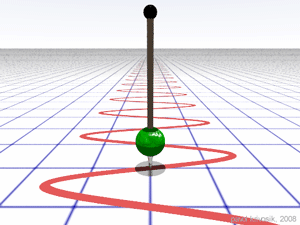What’s Frequency?
Frequency is the number of occurrences of a repeating event per unit of time. It is also occasionally referred to as temporal frequency to emphasize the contrast to spatial frequency, and ordinary frequency to emphasize the contrast to angular frequency. It is measured in hertz (Hz) which is equal to one event per second. The period is the duration of time of one cycle in a repeating event, so the period is the reciprocal of the frequency.
Definitions and Units
For cyclical phenomena such as oscillations, waves, or for examples of simple harmonic motion, the term is defined as the number of cycles or vibrations per unit of time. The conventional symbol is f; the Greek letter v is also used. The period T is the time taken to complete one cycle of an oscillation. The relation between the frequency and the period is given by the equation:
f = 1/T
The term is used to emphasize that the frequency is characterized by the number of occurrences of a repeating event per unit time, and not unit distance.
The SI derived unit is the hertz (Hz), named after the German physicist Heinrich Hertz by the International Electrotechnical Commission in 1930. It was adopted by the CGPM (Conférence générale des poids et mesures) in 1960, officially replacing the previous name, “cycles per second” (cps). The SI unit for the period, as for all measurements of time, is the second. A traditional unit of measure used with rotating mechanical devices is revolutions per minute, abbreviated r/min or rpm. 60 rpm is equivalent to one hertz.
| Frequency | 1 mHz (10-3 Hz) | 1 Hz (100 Hz) | 1 kHz (103 Hz) | 1 MHz (106 Hz) | 1 GHz (109 Hz) | 1 THz (1012 Hz) |
| Period | 1 ks (103 s) | 1 s (100 s) | 1 ms (10-3 s) | 1 μs (10-6 s) | 1 ns (10-9 s) | 1 ps (10-12 s) |
What are Frequency Bands?
The radio spectrum of frequencies is divided into bands with conventional names designated by the International Telecommunications Union (ITU). A frequency band is an interval in the frequency domain, delimited by a lower frequency and an upper frequency. The term may refer to a radio band or an interval of some other spectrum. Frequency Bands are following:
| Frequency Range | Wavelength Range | ITU Designation | IEEE Bands | |
| Full Name | Abbreviation | |||
| Below 3 Hz | >105 km | Tremendously low frequency | TLF | N/A |
| 3–30 Hz | 105–104 km | Extremely low frequency | ELF | N/A |
| 30–300 Hz | 104–103 km | Super low frequency | SLF | N/A |
| 300–3000 Hz | 103–100 km | Ultra low frequency | ULF | N/A |
| 3–30 kHz | 100–10 km | Very low frequency | VLF | N/A |
| 30–300 kHz | 10–1 km | Low frequency | LF | N/A |
| 300 kHz – 3 MHz | 1 km – 100 m | Medium frequency | MF | N/A |
| 3–30 MHz | 100–10 m | High frequency | HF | HF |
| 30–300 MHz | 10–1 m | Very high frequency | VHF | VHF |
| 300 MHz – 3 GHz | 1 m – 10 cm | Ultra high frequency | UHF | UHF, L, S |
| 3–30 GHz | 10–1 cm | Super high frequency | SHF | S, C, X, Ku, K, Ka |
| 30–300 GHz | 1 cm – 1 mm | Extremely high frequency | EHF | Ka, V, W, mm |
| 300 GHz – 3 THz | 1 mm – 0.1 mm | Tremendously high frequency | THF | N/A |
Frequencies of 1 GHz and above are conventionally called microwave, while frequencies of 30 GHz and above are designated millimeter wave. More detailed band designations are given by the standard IEEE letter- band frequency designations and the EU/NATO frequency designations.
The board fabrication under different frequency bands has different demand on PCB materials. MADPCB is a quick-turn high frequency printed circuit board (PCB) manufacturer in China. For more information, feel free to contact us.

